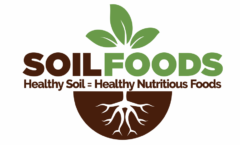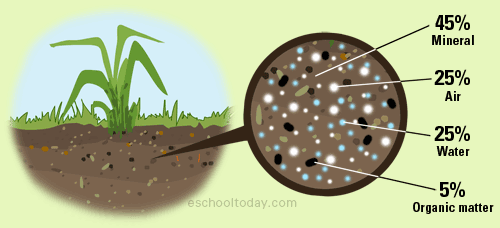
What is Soil?
Soil is a complex mixture of organic matter, minerals, gases, liquids, and organisms that forms the uppermost layer of the Earth’s crust. It serves as the natural medium for plant growth and supports various vital functions in terrestrial ecosystems.

- Organic Matter: This consists of decomposed plants, animals, and microorganisms. Organic matter, often referred to as humus, plays a key role in improving soil fertility, structure, and moisture retention.
- Water: Soil absorbs and holds water, which is essential for plant growth. Water in soil is stored in pore spaces between mineral particles and organic matter, and it provides hydration for plant roots.
- Air: Soil also contains air in the pore spaces, which is essential for the survival of plant roots and soil organisms (like worms, fungi, and bacteria). Soil air provides oxygen and other gases needed for respiration by these organisms.
- Living Organisms: Soil is home to a vast array of organisms, including bacteria, fungi, earthworms, and insects. These organisms play a critical role in nutrient cycling, breaking down organic matter, and promoting soil health.
Soil can vary greatly depending on location, climate, and time, and it is constantly changing and evolving. The health and composition of soil are central to the growth of plants and the function of ecosystems, making it an essential part of the natural environment.
Soil is made up of several components:
Mineral Particles: These are derived from rocks that have broken down over time.
They vary in size and composition, and are classified into three main types based on their particle size:

Sand (largest particles)
Silt (medium-sized particles)
Clay (smallest particles)
If you want to know what Soil Type you are dealing with. Do this simple test – Click Here….
What Minerals - Nutrients are found in Soil?
The three primary macronutrients found in soil are nitrogen (N), phosphorus (P), and potassium (K), collectively known as NPK. These nutrients, along with secondary macronutrients like calcium (Ca), magnesium (Mg), and sulfur (S), as well as various micronutrients, are vital for plant health and crop productivity13.
The availability and balance of these nutrients in soil significantly impact crop yields and quality. Proper management of soil nutrients is crucial for sustainable agriculture, as over-exploitation through harvesting without adequate replenishment can lead to soil degradation and decreased productivity8. Factors such as soil type, pH, organic matter content, and environmental conditions influence nutrient availability and uptake by plants.
Understanding soil nutrition is essential for farmers and agricultural professionals to optimize crop production, maintain soil health, and ensure food security. This knowledge allows for more efficient use of fertilizers, improved crop yields, and the development of sustainable agricultural practices that protect and enhance soil resources for future generations
These 14 nutrients, along with carbon (C), hydrogen (H), and oxygen (O) obtained from air and water, make up the 17 essential elements required for plant growth148. Each nutrient plays a specific role in plant development and cannot be fully substituted by another element4.
Some additional elements, such as silicon (Si), cobalt (Co), and vanadium (V), are considered beneficial for certain plants but are not universally essential3. The availability and balance of these nutrients in the soil significantly impact plant health, growth, and crop yields.
Lorem ipsum dolor sit amet, consectetur adipiscing elit. Ut elit tellus, luctus nec ullamcorper mattis, pulvinar dapibus leo.
Here’s a chart of the essential nutrients found in soil for plant growth and development:
| Category | Nutrient | Symbol | Primary Functions in Plants |
|---|---|---|---|
| Macronutrients | Nitrogen | N | Protein synthesis, chlorophyll production |
| Phosphorus | P | Energy transfer, nucleic acid synthesis | |
| Potassium | K | Enzyme activation, water regulation | |
| Calcium | Ca | Cell wall formation, signal transduction | |
| Magnesium | Mg | Chlorophyll structure, enzyme activation | |
| Sulfur | S | Protein synthesis, chlorophyll production | |
| Micronutrients | Iron | Fe | Chlorophyll synthesis, enzyme function |
| Manganese | Mn | Photosynthesis, enzyme activation | |
| Copper | Cu | Enzyme activation, photosynthesis | |
| Zinc | Zn | Enzyme production, growth regulation | |
| Boron | B | Cell wall formation, flower development | |
| Molybdenum | Mo | Nitrogen metabolism, enzyme function | |
| Chlorine | Cl | Photosynthesis, osmosis regulation | |
| Nickel | Ni | Nitrogen metabolism, enzyme function |
Note: Carbon (C), Hydrogen (H), and Oxygen (O) are also essential for plant growth but are primarily obtained from air and water rather than soil.
This chart provides an overview of the essential soil nutrients, their chemical symbols, and their primary functions in plant growth and development.
Soil Microbes
Soil microorganisms, including bacteria, fungi, actinomycetes, and protozoa, play a vital role in soil health and nutrient cycling3. These “unseen workers” perform several crucial functions:
Converting organic matter and mineral elements into forms available for plant uptake3.
Forming symbiotic relationships with plants to enhance nutrient uptake (e.g., Rhizobium bacteria for nitrogen fixation)3.
Neutralizing soil pH in both acidic and alkaline conditions3.
Improving soil structure and water retention3.
